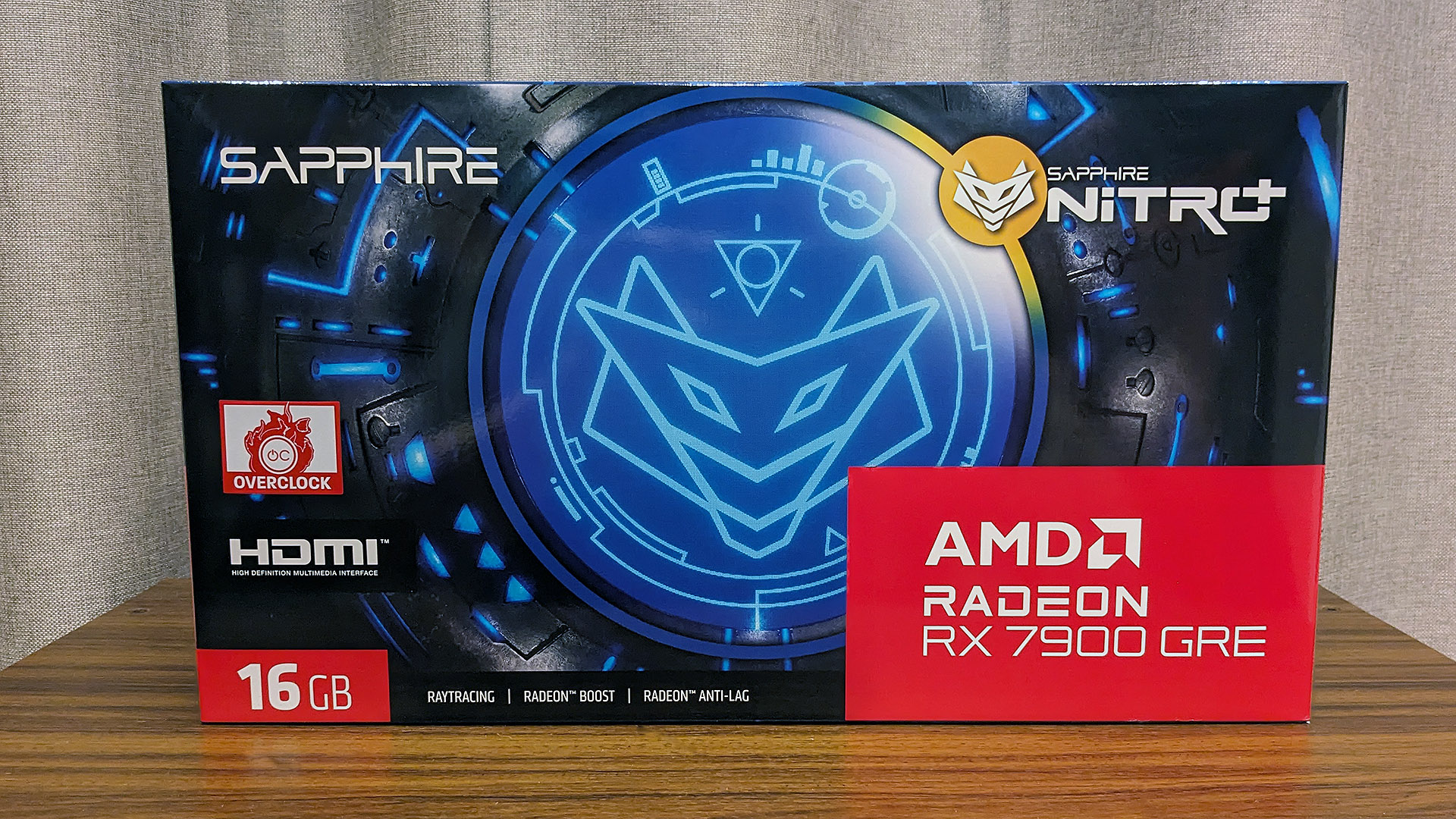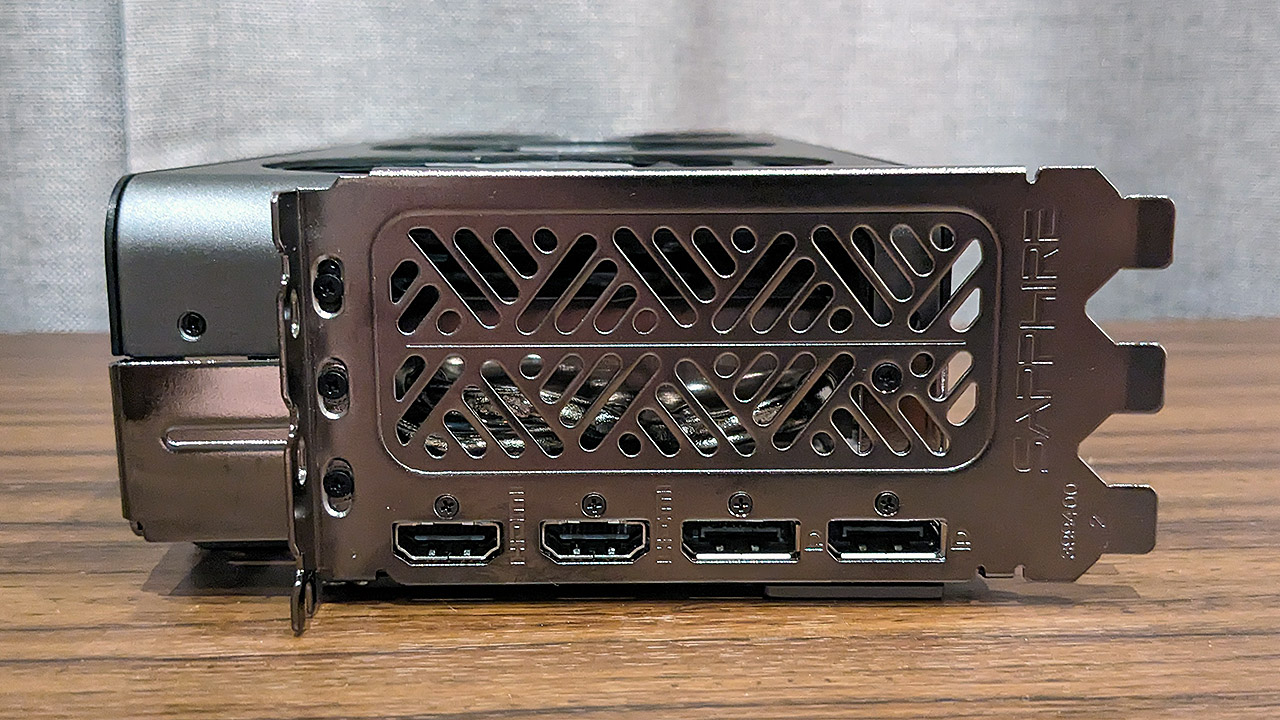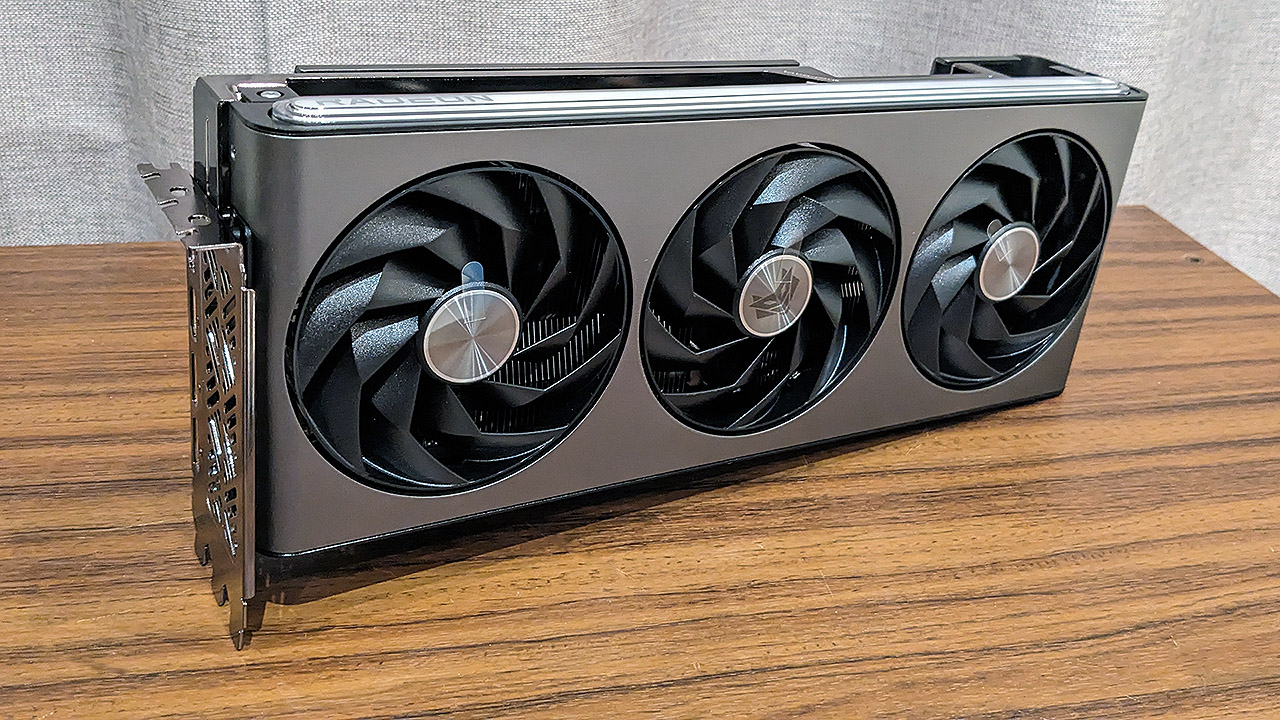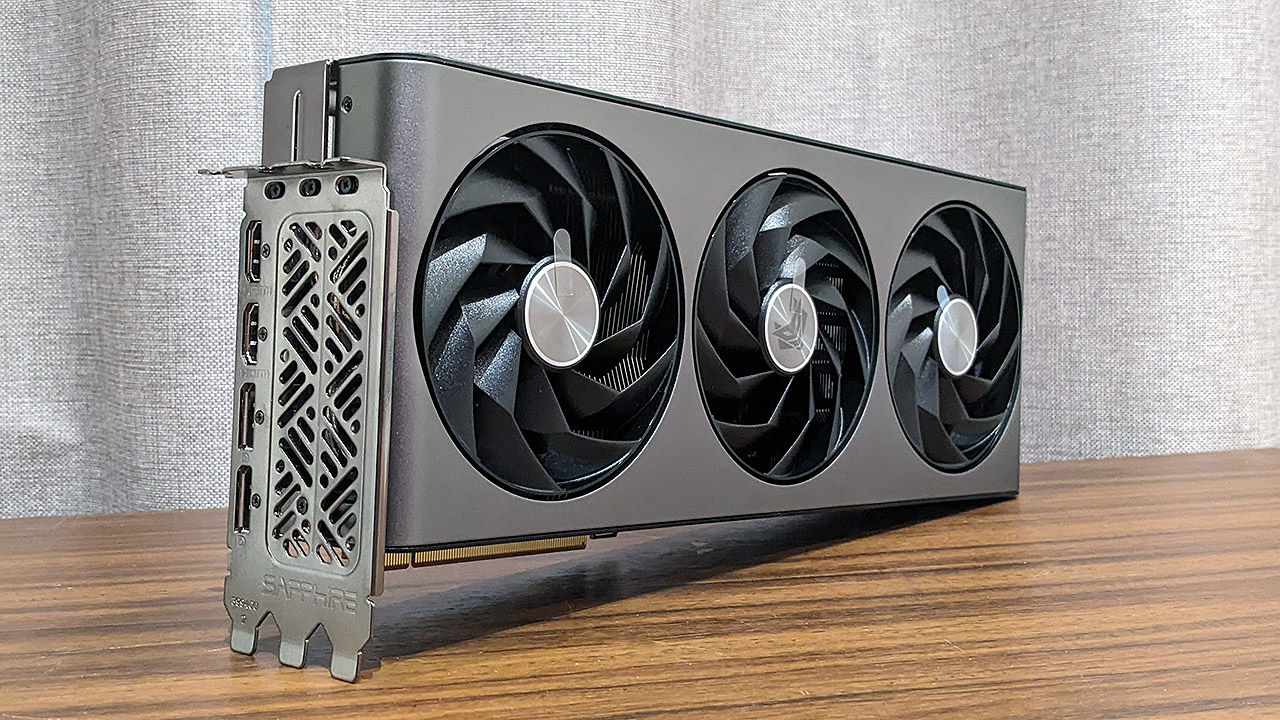Our Verdict
The RX 7900 GRE is the current highlight of the RX 7000 generation. It's a very competitive offering in the $500 to $600 price range that stands up well against the RTX 4070 Super. And I can't help but feel Sapphire's Nitro+ offering is well worth the extra $50 asking price too.
For
- Very competitive performance
- Exceptionally quiet
- 16GB of VRAM
- AMD's software ecosystem is maturing
Against
- Can't match the power efficiency of the RTX 4070 Super
- Ray tracing performance remains a step behind
PC Gamer's got your back
Today we say hello to the AMD Radeon RX 7900 GRE. GRE stands for Golden Rabbit Edition. As you might have guessed given its name, it references the Year of the Rabbit in Chinese culture. The card was originally a China exclusive model, launching in mid 2023, but it has been available in OEM systems in the wider market for a few months, though it has not been available in the channel as a standalone purchase.
That changes from the 27th of February, as the RX 7900 GRE will be available worldwide to purchase as a standalone graphics card. It plugs the sizable price and performance gap that exists between the Radeon RX 7800 XT and the RX 7900 XT. That puts it right in the crosshairs of the RTX 4070 and RTX 4070 Super. The latter recently launched at $599 while base RX 7900 GRE models will launch at $549, the same level as the RTX 4070 was dropped to.
In terms of the core spec, the RX 7900 GRE is essentially a trimmed down RX 7900 XT. It features the same Navi 31 chiplet GPU but with a bit less of, well, everything. AMD will be hoping that the GRE's reasonable price, competitive performance, and surely its 16GB of VRAM will attract buyers.
The original Made by AMD (MBA) GRE model will not be available in the retail channel, so you'll only be able to buy third-party versions. I have the Sapphire Nitro+ RX 7900 GRE on hand for review and it's an absolute beast of a card, with all the trimmings you'd expect from a premium tier model, and at $599, it's markup of $50 is very reasonable.
But is the RX 7900 GRE too late to the party? Let's not forget we've actually ticked over to the Year of the Dragon, which at least makes the name seem a bit anachronistic.
Sapphire Pulse RX 7900 GRE quick verdict

The Sapphire Nitro+ RX 7900 GRE is a card well worth considering if silence is paramount to you. It's hardly audible under sustained loads and my test system's AIO cooling fans were much more noticeable during typical gameplay.
I can't speak for other RX 7900 GRE models, but given the relatively thrifty 260W TDP of this iteration of the Navi 31 GPU, it's a safe bet that pretty much any company's large triple fan coolers will have zero problems handling the cooling requirements of the RX 7900 GRE.
✅ You don't care so much about ray tracing performance: RT is here to stay, but enabling it still results in a big performance hit. Rasterization still matters and the RX 7900 GRE is very good at it.
✅You want a quiet card: The Sapphire Nitro+ is an exceptionally quiet card. It really cannot be heard under most typical operational scenarios.
❌You care a lot about ray tracing and DLSS: More and more modern games support ray tracing. While the RDNA 3 generation is a big step forward in this regard, the RTX 4070 Super's DLSS support and ray tracing performance remains a step ahead.
The Nitro+ is Sapphire's top RX 7900 GRE model. I've written favorably about Nitro+ cards for a long time. They're undeniably premium cards in every way and the RX 7900 GRE version is no different. It's got a healthy factory overclock, a massive 3.5 slots worth of cooling capacity, a full-length metal backplate, 2x HDMI 2.1a, 2x DisplayPort 2.1, dual BIOS and a header for controlling external ARGB products.
But the card has a somewhat minimalist look, at least from the front. The RGB light bar running across the top of the card, however, looks fantastic. As a piece of modern tech, the card feels solid, heavy and well built. In my experience, Nitro+ cards are every bit as good as the best cards from other AMD vendors.
Other than achieving very low noise levels, the Nitro+ cooler is able to keep temperatures well within check, with a peak load temperature of 65°C. Sapphire could probably be a little more aggressive with its fan profile, but I'll take silence over a few extra MHz of boost clock any day. Speaking of boost clocks, the Nitro + RX 7900 GRE was able to hold a boost clock of 2,276MHz. Unusually, that's lower than its highest rated boost clock of 2,391MHz.
Performance wise, the RX 7900 GRE sits about exactly where I expected it to even before I'd plugged it in; right in the middle of the RX 7800 XT and RX 7900 XT. At 4K, the GRE is about 15% faster than the RX 7800 XT on average, and 15% slower than the RX 7900 XT. Crucially, the Sapphire is on par with the RTX 4070 Super while costing the same $599.
As for which card you should go for, the old AMD vs Nvidia tropes remain relevant here. The RTX 4070 Super has superior power efficiency and ray tracing performance, while the RX 7900 GRE has better raster performance. Nvidia still has an advantage with its DLSS 3 and Frame Generation tech, but AMD is catching up with FSR 3 and its Fluid Motion Frames technology.
Sapphire Pulse RX 7900 GRE specs

Note that the specifications listed below are for AMD's reference models. That Sapphire I'm reviewing here comes with a higher boost clock.
| Header Cell - Column 0 | RX 7900 GRE | RX 7800 XT | RX 7900 XT | RX 7900 XTX |
|---|---|---|---|---|
| GPU | Navi 31 XL | Navi 32 XT | Navi 31 XT | Navi 31 XTX |
| Shader cores | 5,120 | 3,840 | 5,376 | 6,144 |
| Ray accelerators | 80 | 60 | 84 | 96 |
| AI accelerators | 160 | 120 | 168 | 192 |
| Boost clock (MHz) | 2,245 | 2,430 | 2,400 | 2,500 |
| Infinity (L3) cache | 64MB | 64MB | 80MB | 96MB |
| Memory | 16GB 18Gbps GDDR6X | 16GB 19.5Gbps GDDR6 | 20GB 20Gbps GDDR6X | 24GB 20Gbps GDDR6 |
| Memory bus | 256-bit | 256-bit | 320-bit | 384-bit |
| TGP | 260W | 263W | 300W | 355W |
| Launch date | July 27th, 2023 | August 25th, 2023 | November 3rd, 2022 | November 3rd, 2022 |
| Launch price | $549 | $499 | $899 | $999 |
The RX 7900 GRE is based on AMD's RDNA 3 architecture and it's the third card to ship with the Navi 31 GPU after the RTX 7900 XTX and RX 7900 XT. The GRE has 5,120 stream processors, 80 Ray Accelerators and 160 AI processors. That's not all that far behind the RX 7900 XT, but its lower 260W TDP means it has to sacrifice some clock speeds compared to the RX 7900 XT. Interestingly, that 260W TDP is less than the 263W TDP of the slower RX 7800 XT.
If you'd like to read more about the RDNA 3 architecture, it's well worth checking out Jacob's review of the reference RX 7900 XTX. The Navi 31 GPU introduces a radical (for a GPU) chiplet design that splits the Compute Units from the cache and memory controllers. Of course, there's a lot more to it than just that, but it's a rather amazing piece of engineering, especially given the bandwidth demands of modern GPUs. The need for bandwidth and the adoption of a chiplet design led to AMD developing what it calls the Infinity Link, which can provide up to 5.3 TB/s of bandwidth. Impressive to say the least.
The GRE comes with four of the maximum six MCDs active. This means the memory system is substantially cut down from the higher tier RX 7900 models. The end result is a total of 16GB of 18Gbps GDDR6 memory and a 256-bit bus. By modern standards, that's quite reasonable—particularly compared to the RTX 4070 Super with its 12GB of memory and 192-bit bus.

The Sapphire Nitro+ comes with dual HDMI 2.1a and dual DP 2.1. The latter is still missing in action on RTX 40-series cards. That DP 2.1 support is one of those little features that will eventually into its own with future monitors with high resolutions and very high refresh rates, though both of those will arguably have little relevance to this card when they do arrive.
Other interesting features include an RGB header for controlling an external strip and dual BIOS with performance and quiet modes.
AMD has long been at work developing its FSR and accompanying technologies. Fluid Motion Frames is just one example. FSR 3 is still new, and it has a long way to go to catch up to Nvidia's ever expanding DLSS support, but it's getting there. Games like Starfield and COD: Modern Warfare 3 are just two notable examples of games with FSR 3 support. Part of the full feature mix of FSR 3 is its own Frame Generation engine, one that has to be enabled on a per-game basis by the devs, but AMD also has another solution.
Fluid Motion Frames is AMD's game agnostic Frame Generation competitor. It's similar to Nvidia's version, but very different. Unlike DLSS 3 Frame Generation, AMD's solution is software based, and doesn't require machine learning capabilities. AFMF is also able to be used in any DirectX 11 or 12 game. Consider that a really good value add for a card like the RX 7900 GRE if you're struggling to hit or maintain that all important 60 FPS threshold.
Sapphire Pulse RX 7900 GRE benchmarks
Sapphire Pulse RX 7900 GRE performance

At 1080p, we see the RX 7900 GRE edging out the RTX 4070 Super overall in traditionally rasterized titles, but in games with ray tracing, such as Cyberpunk 2077 and to a lesser extent, Metro Exodus Enhanced, the RTX 4070 Super retakes the lead. We've heard this all before, haven't we? The RX 7900 GRE is a very capable card, but Nvidia's competing RTX models remain a step ahead in ray tracing performance.
1440p is the sweet spot for the GRE, capable of hitting around 90 FPS+ in non-ray traced games. At 4K the card starts to run out of a bit of horsepower, though enabling scaling technologies will mean the RX 7900 GRE is still a capable 4K card, as long as you don't ask too much of it by cranking up the ray tracing eye candy.
The RX 7900 GRE destroys the RX 6900 XT in both efficiency and performance.
The Sapphire's cooler is a match for any on the market. It's not like the other cards, even reference ones do a bad job at cooling, but AMD's RX 7000 reference coolers do have to resort to higher noise levels to offset their more compact dimension. Chalk up a solid reason to spend the extra $50 for the Sapphire right there. It really is a quiet card.
The power consumption numbers are about as expected. The RTX 4070 and RTX 4070 Ti Super cards are amazingly power efficient, but the GRE isn't too bad in that regard. Its 260W TDP gives it good performance per watt, and interestingly, the RX 7900 GRE absolutely destroys the RX 6900 XT in both efficiency and performance, showing what the change from RDNA 2 to 3 has delivered. There is no reason to buy a 6900 XT or 6950 XT anymore unless you get one second hand or at a fire sale.
Overall it's a fairly strong showing for the RX 7900 GRE. Unless—and you just know what I'm going to say—you rate DLSS 3, Frame Generation and ray tracing performance highly. They haven't been fringe technologies for a long time, so it's something you will need to consider if they're important to you.
Sapphire Pulse RX 7900 GRE analysis

I'm a little bit curious as to why AMD originally chose to only release the RX 7900 GRE in China only, and why it's now opening that restriction up. I guess it's a combination of factors. It's surely a response to Nvidia's RTX Super cards, but it's also likely to have lower margins given its complexity. Anyway, it's here, and it's a welcome competitor in the upper mid-range graphics card market.
The RX 7900 GRE is faster than the RX 7800 XT and slower than the RX 7900 XT, exactly as expected. What it does do is take some appeal away from the RX 7800 XT. It needs to consistently drop below $500 to remain relevant. Otherwise spending the extra $50 on the GRE is a bit of a no-brainer. At the same time as the release of the GRE, AMD is officially announcing a price drop for the RX 7700 XT to $419, which creates a bit of a gap for the 7800 XT to fall into. AMD has not announced a 7800 XT price drop though.
The RX 7900 GRE is a very good RTX 4070 Super competitor. You could say the GRE is the faster card, but only in situations where ray tracing is absent, it's also $50 cheaper, although the Sapphire is priced at the same $599 as base RTX 4070 Supers. The GRE has a memory bandwidth and capacity advantage, while the Super retains the edge in power efficiency. I think choosing between the two is difficult. Personally, I'd just lean towards the RTX 4070 Super, but by a hair's width. Its more mature software ecosystem remains a very good value add.
I feel as though the RX 7900 GRE is currently the most appealing card of the RX 7000-series lineup
The Sapphire Nitro+ RX 7900 GRE will set you back $50 over the cost of base cards. In my opinion, it's well worth the extra moolah. The cooler alone is worth the extra money. It's built like a battleship, it's all but silent and it's more than capable of taming a 260W TDP. The RGB light bar looks great and you get an excellent PCB with dual BIOS and an ARGB header.
This is the first 7900 GRE card I have tested, so I cannot say how it stacks up performance wise to other versions, but I was a little surprised the Sapphire was not able to reach clocks far beyond the 2,245MHz reference clock. It was able to hold an average of 2,276MHz over a long run, so that's still better. Perhaps we're seeing power constraints kick in, as the TDP of the is some 40W less than the RX 7900 XT.
In conclusion, I feel as though the RX 7900 GRE is currently the most appealing card of the RX 7000-series lineup. Premium RX 7900 XT's are a big step up in price, and the RX 7800 XT is suddenly too expensive. The RTX 4070 Super is a very capable and appealing competitor but the RX 7900 GRE stands up well. This is the kind of competition we like to see in the graphics card marketplace.
The RX 7900 GRE is the current highlight of the RX 7000 generation. It's a very competitive offering in the $500 to $600 price range that stands up well against the RTX 4070 Super. And I can't help but feel Sapphire's Nitro+ offering is well worth the extra $50 asking price too.

Chris' gaming experiences go back to the mid-nineties when he conned his parents into buying an 'educational PC' that was conveniently overpowered to play Doom and Tie Fighter. He developed a love of extreme overclocking that destroyed his savings despite the cheaper hardware on offer via his job at a PC store. To afford more LN2 he began moonlighting as a reviewer for VR-Zone before jumping the fence to work for MSI Australia. Since then, he's gone back to journalism, enthusiastically reviewing the latest and greatest components for PC & Tech Authority, PC Powerplay and currently Australian Personal Computer magazine and PC Gamer. Chris still puts far too many hours into Borderlands 3, always striving to become a more efficient killer.


